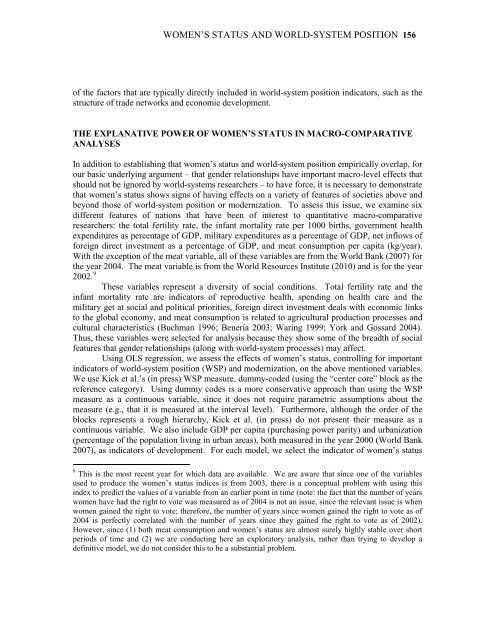Entire Volume 17 issue 1 - Journal of World-Systems Research ...
Entire Volume 17 issue 1 - Journal of World-Systems Research ...
Entire Volume 17 issue 1 - Journal of World-Systems Research ...
Create successful ePaper yourself
Turn your PDF publications into a flip-book with our unique Google optimized e-Paper software.
WOMEN’S STATUS AND WORLD-SYSTEM POSITION 156<br />
<strong>of</strong> the factors that are typically directly included in world-system position indicators, such as the<br />
structure <strong>of</strong> trade networks and economic development.<br />
THE EXPLANATIVE POWER OF WOMEN’S STATUS IN MACRO-COMPARATIVE<br />
ANALYSES<br />
In addition to establishing that women’s status and world-system position empirically overlap, for<br />
our basic underlying argument – that gender relationships have important macro-level effects that<br />
should not be ignored by world-systems researchers – to have force, it is necessary to demonstrate<br />
that women’s status shows signs <strong>of</strong> having effects on a variety <strong>of</strong> features <strong>of</strong> societies above and<br />
beyond those <strong>of</strong> world-system position or modernization. To assess this <strong>issue</strong>, we examine six<br />
different features <strong>of</strong> nations that have been <strong>of</strong> interest to quantitative macro-comparative<br />
researchers: the total fertility rate, the infant mortality rate per 1000 births, government health<br />
expenditures as percentage <strong>of</strong> GDP, military expenditures as a percentage <strong>of</strong> GDP, net inflows <strong>of</strong><br />
foreign direct investment as a percentage <strong>of</strong> GDP, and meat consumption per capita (kg/year).<br />
With the exception <strong>of</strong> the meat variable, all <strong>of</strong> these variables are from the <strong>World</strong> Bank (2007) for<br />
the year 2004. The meat variable is from the <strong>World</strong> Resources Institute (2010) and is for the year<br />
2002. 9<br />
These variables represent a diversity <strong>of</strong> social conditions. Total fertility rate and the<br />
infant mortality rate are indicators <strong>of</strong> reproductive health, spending on health care and the<br />
military get at social and political priorities, foreign direct investment deals with economic links<br />
to the global economy, and meat consumption is related to agricultural production processes and<br />
cultural characteristics (Buchman 1996; Benería 2003; Waring 1999; York and Gossard 2004).<br />
Thus, these variables were selected for analysis because they show some <strong>of</strong> the breadth <strong>of</strong> social<br />
features that gender relationships (along with world-system processes) may affect.<br />
Using OLS regression, we assess the effects <strong>of</strong> women’s status, controlling for important<br />
indicators <strong>of</strong> world-system position (WSP) and modernization, on the above mentioned variables.<br />
We use Kick et al.’s (in press) WSP measure, dummy-coded (using the “center core” block as the<br />
reference category). Using dummy codes is a more conservative approach than using the WSP<br />
measure as a continuous variable, since it does not require parametric assumptions about the<br />
measure (e.g., that it is measured at the interval level). Furthermore, although the order <strong>of</strong> the<br />
blocks represents a rough hierarchy, Kick et al. (in press) do not present their measure as a<br />
continuous variable. We also include GDP per capita (purchasing power parity) and urbanization<br />
(percentage <strong>of</strong> the population living in urban areas), both measured in the year 2000 (<strong>World</strong> Bank<br />
2007), as indicators <strong>of</strong> development. For each model, we select the indicator <strong>of</strong> women’s status<br />
9 This is the most recent year for which data are available. We are aware that since one <strong>of</strong> the variables<br />
used to produce the women’s status indices is from 2003, there is a conceptual problem with using this<br />
index to predict the values <strong>of</strong> a variable from an earlier point in time (note: the fact that the number <strong>of</strong> years<br />
women have had the right to vote was measured as <strong>of</strong> 2004 is not an <strong>issue</strong>, since the relevant <strong>issue</strong> is when<br />
women gained the right to vote; therefore, the number <strong>of</strong> years since women gained the right to vote as <strong>of</strong><br />
2004 is perfectly correlated with the number <strong>of</strong> years since they gained the right to vote as <strong>of</strong> 2002).<br />
However, since (1) both meat consumption and women’s status are almost surely highly stable over short<br />
periods <strong>of</strong> time and (2) we are conducting here an exploratory analysis, rather than trying to develop a<br />
definitive model, we do not consider this to be a substantial problem.





